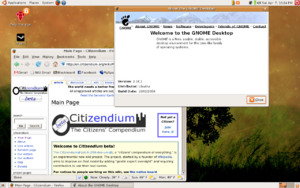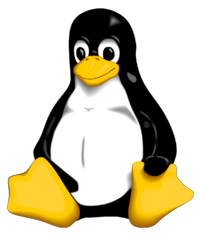Linux (operating system): Difference between revisions
imported>Christopher J. Reiss m (Changed the intro to say what Linux *is*, rather than quibbling over terminology) |
imported>John Dvorak mNo edit summary |
||
| Line 41: | Line 41: | ||
{{dablink|For other meanings of the term "Linux", see [[Linux (disambiguation)]].}} | {{dablink|For other meanings of the term "Linux", see [[Linux (disambiguation)]].}} | ||
''Linux'' is an operating system similar in purpose to Microsoft Windows and Apple OSX. Unlike Windows and OSX, Linux is free and runs on both Intel (Windows) and Apple platforms. | |||
'''Linux''' is an operating system similar in purpose to Microsoft Windows and Apple OSX. Unlike Windows and OSX, Linux is free and runs on both Intel (Windows) and Apple platforms. | |||
Linux comes in a variety of distributions or packages. A distribution bundles the core operating system with a suite of free software typically including email, web browsing, multimedia and office applications. The most popular distribution for the Intel PC is Ubuntu, which is designed for ease of installation and use. | Linux comes in a variety of distributions or packages. A distribution bundles the core operating system with a suite of free software typically including email, web browsing, multimedia and office applications. The most popular distribution for the Intel PC is Ubuntu, which is designed for ease of installation and use. | ||
Revision as of 16:53, 20 April 2008
| Linux |

|
| The GNOME desktop on Ubuntu Linux 6.10 |
| Website: http://www.kernel.org/
Official site for Linux kernel development |
| Created by: Linus Torvalds (Linux kernel)
and Richard Stallman (GNU Utilities) |
| Developer: The Open Source community |
| OS family: Unix-like |
| Source model: Open source |
| Supported platforms:
AMD64, ARM, DEC Alpha, |
| Kernel type: Modular monolithic |
| Default user interface (most distros): GUI |
| License: GNU General Public License |
| Working state: Current |

Linux is an operating system similar in purpose to Microsoft Windows and Apple OSX. Unlike Windows and OSX, Linux is free and runs on both Intel (Windows) and Apple platforms.
Linux comes in a variety of distributions or packages. A distribution bundles the core operating system with a suite of free software typically including email, web browsing, multimedia and office applications. The most popular distribution for the Intel PC is Ubuntu, which is designed for ease of installation and use.
The surge in the popularity of Linux in the past decade has contributed to the popularity of open source software in general, and brought the ideals and methodologies of both the open source crowd and the free software movement into the limelight.
History
Development of the Linux kernel was started in 1991 by a Finnish college student named Linus Torvalds. At the time, the majority of Unix systems were very expensive. The only affordable workstation environment was a proprietary system called Minix. Although the source code was included with this system, the license fee was still a bit pricey, and it was not as robust or feature complete as the systems the workstations in the universities were running.
The name
Originally, Torvalds had intended to call the system Freax, for Free, Freaks, and Unix. The original source code up to version 0.11 made reference to this, such as a comment in the Makefile, "Makefile for the freax kernel". However, the kernel's FTP directory at nic.funet.fi was named Linux, in honor of its creator, of course, with an x to denote that it is Unix-like. This name caught on, and has been the official alias ever since. Linux is pronounced like 'Minix' - that is, "'li' is pronounced with a short [ee] sound: compare prInt, mInImal etc.'nux' is also short, non-diphtong, like in pUt."[1]
GNU/Linux controversy
At the same time Linux was being created, the Free Software Foundation (FSF) led by Dr. Richard Stallman began work on a similar project called GNU. The GNU system was a multi-person project which aimed to provide a suite of software together with the operating system kernel. The GNU group began not with the kernel, but rather by developing various tools such as a compiler (GNU C Compiler) and a text editor (Emacs). The GNU group never did complete their system with an operating system kernel. As a result, free software enthusiasts started to use Linux's kernel alongside GNU's suite of tools. Such combinations came to be called Linux Distributions. The FSF refers to a Linux Distribution as GNU/Linux. This convention has been very controversial, however. Torvalds does not support this terminology, saying that "calling Linux in general just 'GNU/Linux' I think is ridiculous."[2]
Interface
The majority of Linux distributions allow the use of both a GUI (Graphical User Interface) and a CLI (Command Line Interface). In the last few years, many distributions have focused on improving the graphical interface to increase the accessibility of the interface to new users. Ubuntu, widely believed to be the most used Linux distribution, is going to have a complete visual refresh for its next release [3].
Desktop environments
There are many desktop environments available for Linux. This means that there used to be little consistency between distributions. However, in a effort to prevent this, freedesktop.org have introduced the "Tango Theme Guidelines" - a set of guidelines that icon creators are encouraged to adhere to. This includes a color palette and a set of naming conventions.
GNOME
GNOME (GNU Network Object Model Environment) is a desktop environment created by the GNU Project focused on easy of use. It is made of entirely open source software, and the most recent stable release is 2.20, which was released in September 2007. GNOME is the default desktop environment for many distributions, most notably Debian, Fedora Core, openSUSE and Ubuntu (Linux distribution).
KDE
KDE (K Desktop environment) is another desktop environment, but is focused on allowing the user to configure as much as possible. The main distributions that use KDE are Kubuntu and MEPIS. Currently, the KDE developers are testing a major new release: KDE4, which is planned for release on 11 January 2007. It is being upgraded to the Qt4 toolkit, and increases in speed over KDE3 are planned. A new theme, known as the "Oxygen icon set", will be included.
Xfce
Xfce is a desktop environment designed to give a compromise between eye candy and speed. The latest release is 4.4.1. Xfce is not as popular as GNOME or KDE, but some distributions use Xfce as the default desktop environment, including Dreamlinux and Zenwalk.
Fluxbox
Fluxbox is a lightweight desktop environment, aimed at low-end computers. It is designed for speed, but allows eye-candy including transparency. The project recently passed its 1.0 release milestone.
Package Management
There are several different package management systems for Linux. Since most applications are open source, packages can be installed by compilation from source code. Some distributions aimed at experts use this format, including Gentoo and Sabayon Linux. However, most Linux distributions have binary packages available for download. Debian and Debian-based distributions (including Ubuntu) use the .deb package format, along with the "APT" package manager. This allows packages to be upgraded, removed and installed, dealing with all of the dependencies. Other distributions use the .rpm format. However, this package format was initially unpopular due to its poor handling of dependencies (known as "dependency hell"). OpenSUSE, Mandriva and Fedora Core all use the .rpm package format.
References
- ↑ Linus Torvalds (Accessed April 23rd, 2007). How to pronounce "Linux"?.
- ↑ The "GNU/Linux" and "Linux" Controversy (Retrieved April 6th, 2007).
- ↑ Ubuntu to get visual refresh with Hardy Heron